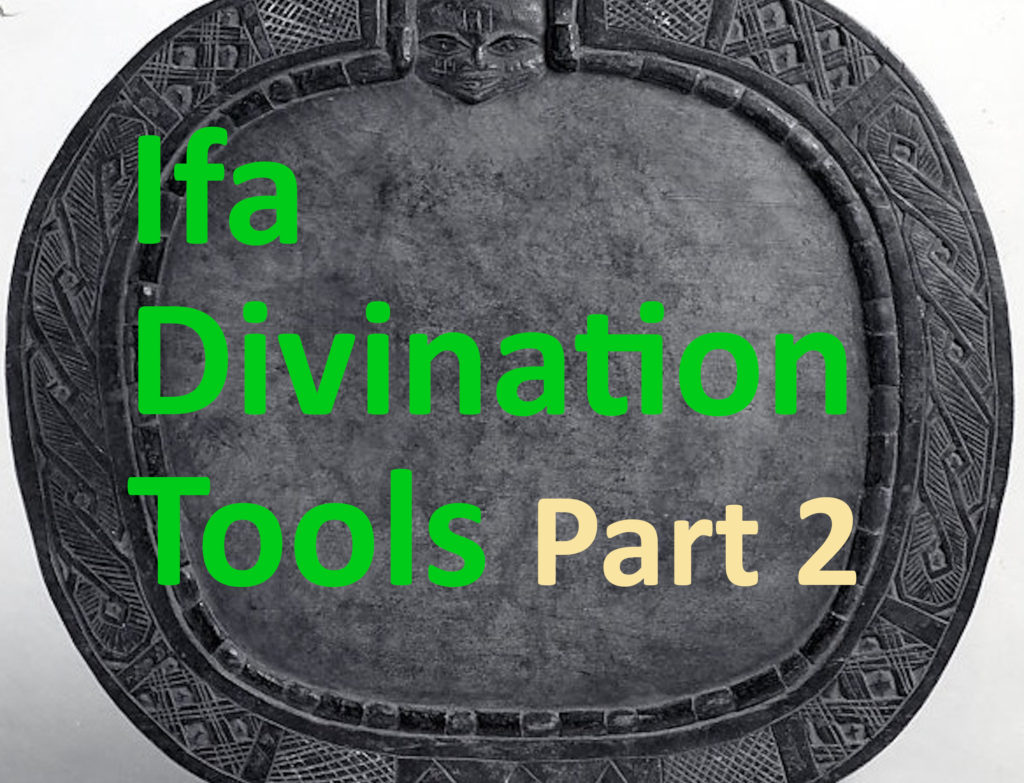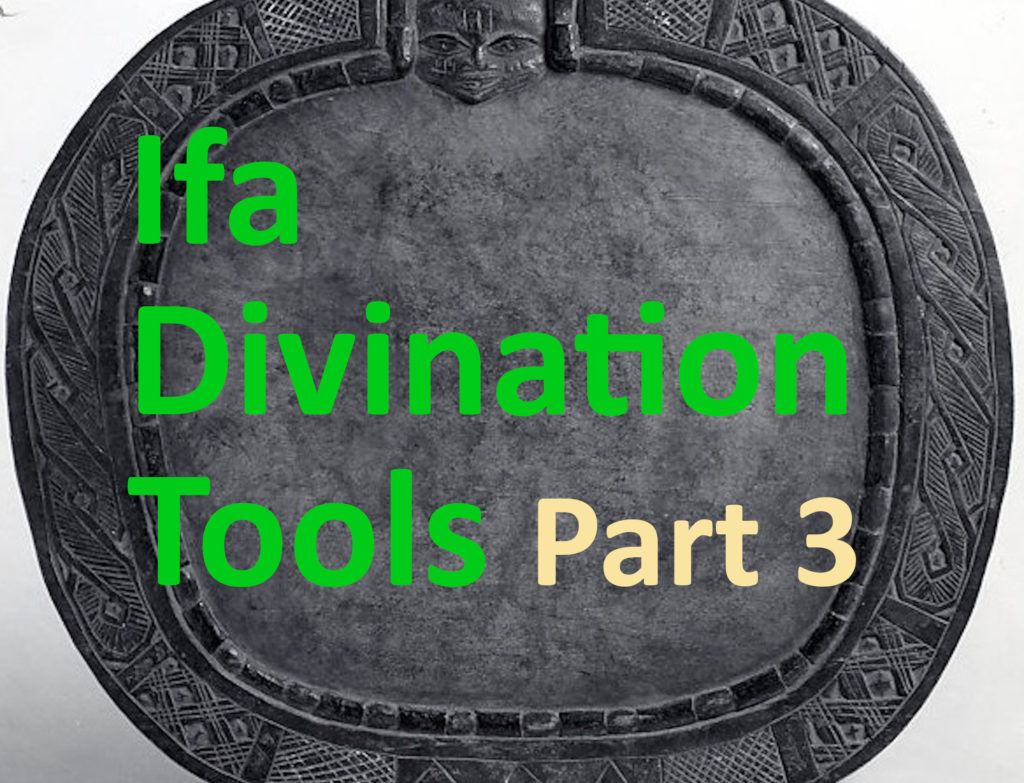In this article we will review a few common tools such as the opon Ifa, iyerosun divination powder, the iroke Ifa, the opele divination chain and the irukere. These tools are used by a Babalawo or Iyanifa for Ifa divination. Included in this article are descriptions of how the tools are used in the process of divination.
Haga clic aquí para leer en Espanol
What is Ifa divination?
Ifa divination is a system of divination that relies on a corpus of oral literature known as odu Ifa. A foundational oral literature comprised of a system of signs that contain all potential outcomes In life. These odu ifa signs are interpreted by a diviner known as a Babalawo, a male Ifa priest or Iyanifa, a female Ifa priestess. The Ifa divination system is primarily used to seek information that helps us to make important and better-informed decisions about potentially life long impactful situations.
The Ifa divination system is associated with the Ifa Yoruba religion and Yoruba spirituality traditions which was conceptualized by the Yoruba people long ago. It is considered to be an ancient practice that predates Christianity and Islam. An estimated time period of origin is unattainable due to lack of historical documentation.
Odu Ifa or oddun is a collection of 16 major odu Ifa (oju odu) signs and 240 minor odu Ifa signs that result in a total of 256 odu Ifa signs containing the wisdom and guidance of Ifa. The oddun contain universal and timeless information that can be applied to any situation.
It is through these sacred gems that wisdom and knowledge is found to help guide all of humanity in a positive and progressive manner. The literary corpus odu Ifa is what creates the foundation to the Ifa divination system.
The practice of Ifa divination has traveled and engraved itself throughout the world by various methods. Some of which include the African diaspora between the 1500’s and 1800’s. Due to this, Ifa practice lives on through newly spawned versions of the Yoruba religion.
By way of an Ifa reading the system of Ifa divination allows us to communicate and consult with the universal powers of Ifa or Orunmila, the deity of wisdom and knowledge. This communication helps to determine the potential outcomes in a situation for which a person or community seeks advice and guidance. It is a way to help determine the best way to live life.
Learn more about the Ifa divination system here
Tools for Ifa divination
The process of using the Ifa divination system involves the use of various divination tools. Each divination tool is used for a specific reason and plays an important role in the process of divination.
There are also multiple methods used by a Babalawo to communicate with Orula or Ifa. The specific divination tool chosen by the diviner depends on the method chosen for divination.
In the following sections of this article we describe the most common ifa divination tools used and for which methods of divination. A description of how they are used is also described.
Opon Ifa
What is opon Ifa?
The opon Ifa is a sacred divination tray traditionally used as a vital tool in the process of Ifa divination. They are typically carved out of wood by traditional Yoruba wood carvers who specialize in ifa divination trays. Most of them are carved into a circular shape or a rectangular shape. Some others are carved with both shapes integrated with the outer part being rectangle while the inner or middle part being circular.
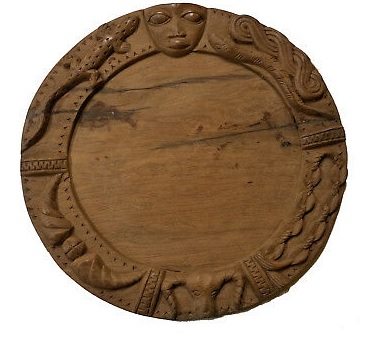
Circular shaped opon Ifa
The surrounding edge of the ifa divination tray is raised which creates a container in the center to hold sacred materials such as iyerosun also known as divination powder and other materials used for Ifa work.
The surrounding raised part of the opon tray will have a series of artistic markings and carvings. Each of these carved figures represent a spiritual meaning and have a special function that aid during Ifa divination. They include carvings of animals that are significant to Ifa such as snakes, bush rats, mud fish and lizards. They may also include carvings of human figures representing male and female.

Rectangle shaped opon Ifa
A Babalawo may also request an opon to be designed with special carvings that align to himself and his own specialties in the Ifa religion. These custom carvings on the perimeter of the tray may suggest the status of the Babalawo in the community.
All divination trays may be unique in one way or another but all of them will have common attributes. One of those common attributes that you will notice among all opon ifa divination trays is the face of Esu carved on the top side of the tray.
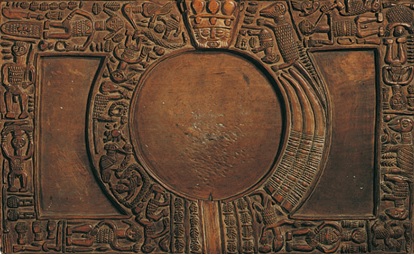
Rectangle with inner circular shape opon Ifa
Esu is a very powerful Orisha that aids in the communication between the diviner and Ifa. He is known as the messenger between humans and Olofin the supreme being.
How the opon Ifa divination tray is used
A Babalawo primarily uses an opon Ifa divination tray to mark the odu ifa signs while communicating with Ifa. He will sit in front of an open door or window on a straw mat facing east with the bottom of the tray closest to him.
The Babalawo will spread iyerosun powder evenly throughout the tray making sure it is completely covered. This will allow for the marking of odu as they are revealed through communication with Ifa.
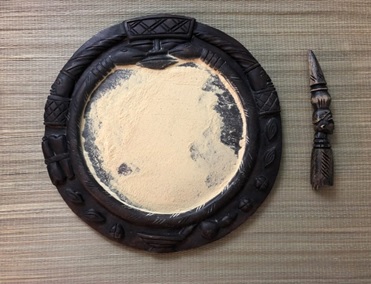
Iyerosun powder spread on opon Ifa
The invocation of Ifa starts with an Ifa prayer known as mojuba. While reciting the mojuba prayer the diviner will make use of the iroke Ifa or diviner’s tapper (shown to the right of the opon Ifa in the picture above). This is used to make noise by tapping the opon divination tray while praying the mojuba prayer to invoke Ifa.
Acknowledgement and homage are properly demonstrated to all entities including Olodumare, Orunmila, Orisha and Eggun as part of the invocation process. Once the attention of Ifa has been obtained, the diviner will commence with communicating with Ifa about the topic a person or community is seeking advice and guidance for.
The diviner will use ikin Ifa (sacred palm nuts) in combination with the opon divination tray and iyerosun powder for Ifa divination. This method of divination is also known as Dafa. The communication with Ifa will reveal the odu to the diviner at which point it will be marked in the iyerosun powder.
Learn more about the ikin divination process here
The odu will contain the information that aligns to the question or issue being investigated. Knowing this information will help bring clarity and deeper understanding of what is being asked during the consultation. This ultimately aids in better decision making.
The opele may also be used in combination with opon ifa but it is not a requirement. A Babalawo or Iyanifa will start the process of divining using Ikin (sacred palm nuts) and can end the divination session with the opele chain.
This may depend on the time available for the divination session. Consulting Ifa using ikin ifa (sacred palm nuts) involves more steps to retrieve an odu compared to using the opele chain.
Learn more about the energy patterns represented in the opon ifa here
Iyerosun powder
Iyersoun powder is used for Ikin Ifa divination. It is spread evenly across the top of the opon ifa divination tray creating a thin layer of the powder. This allows the Babalawo to mark the odu ifa while divining with ikin (sacred palm seeds).
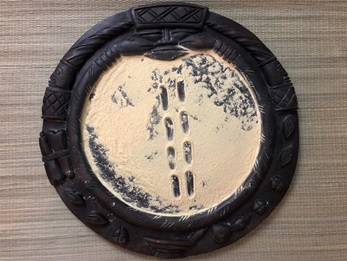
Eji Ogbe odu marked in iyerosun powder
Ifa divination powder is a natural organic substance that comes from the Irosun tree. This tree is believed to have strong energy connections with the spiritual world. The powder is created by termites breaking down the tree, in other words termite dust.
Iyerosun is a requirement for ikin Ifa divination. Whiteout it, the Babalawo or Iyanifa will not be able to mark the odu Ifa.
Learn more about the structure of odu ifa signs here
Iroke Ifa
Iroke Ifa is another tool used by a Babalawo or Iyanifa during divination. This tool is used in combination with the opon Ifa among the other tools mentioned in this article.
The iroke goes by various names, the most popular being iroke. Other names you may come across are orunke, orun ike, irofa, iro ifa, iro ike, orunfa, or orun ifa.
This tool is typically carved from ivory, although they are also made from wood or brass. The inside is left hollow to allow room for a metal object attached to the inside to move back and forth. This is the same concept as a bell to make noise.
The top part of the iroke is shaped into an elephant tusk. The middle part of the iroke will usually be carved to depict a human head while others will be carved to depict a figure kneeling down. The kneeling position signifies respect and loyalty from the Babalawo to Ifa.
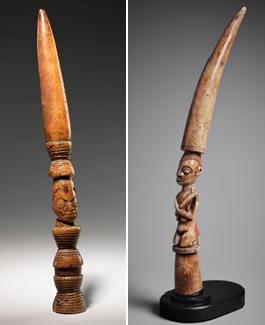
Iroke with only human head carved (left) and Iroke with human figure kneeling (right)
Iroke Ifa is also known as a diviner’s tapper. Its primary job is to attract the attention of Ifa when starting a divination session. A Babalawo or Iyanifa starts an Ifa divination session by tapping on the opon Ifa with the pointed end of the iroke. The diviner will recite the mojuba prayer to acknowledge and pay homage to Olodumare, Orunmila, Orisha and Eggun as part of this invocation process.
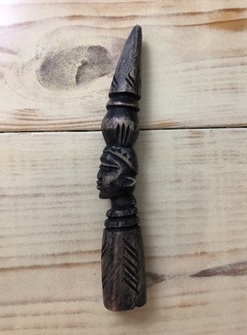
This step in the Ifa invocation process ensures the communication between the Babalawo and Ifa or Orula the deity of wisdom and knowledge, is well established. The divining tapper is also used to summon the attention of the orishas, deity’s and ancestors.
Irukere
Irukere or iruke is a tool used in Yoruba religion rituals while reciting Ifa prayers, chants, blessings and cleanings. It also aids the Babalawo or Iyanifa in the process of Ifa divination. This tool may also be known as a Yoruba fly whisk.
Irukere are typically made from a cow or horse tail held together by a handle at the base of the tail. Some others are made with a longer handle, like a short pole about 24 inches or so wrapped with a cow or a horse tail.
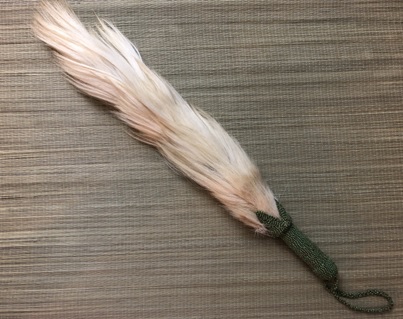
Irukere with green and brown beaded handle
The handle itself is typically made from wood. The type of wood used for each handle may differ from region to region of the world. The base of the wooded handle may be covered by leather and / or beads. The colors of the animal hair and the handles also vary depending on which orisha or deity the Irukere was designed for.
Iruke Ifa have the Ase (power) to drive away evil forces when used properly during cleansing rituals. Most of the time Orisha shrines contain an irukere as part of the decorations.
During the Ifa divination process a Babalawo (Ifa priest) or Iyanifa (Ifa priestess) may use it to invoke the Ase of Ifa during the prayers.
They may also be used during consultations as well as during rituals and ceremonies.
Ifa priests may use them to provide blessings to a person or to a community.
Iruke is also very much a symbol of status and are used by Yoruba kings, queens and chiefs. They are a representation of authority and respect.
Opele ifa
Opele Ifa or sometimes referred to as ekuele is a very common divination tool used by a Babalawo or Iyanifa. It is quite common due to the efficiency it provides for divining. It is very practical and convenient when the diviner is mobile or on the go. The opon Ifa is not a requirement when using the opele divining chain.
The opele chain is made from eight half nuts from the opele fruit tree. The opele nuts when cut in half create a concave and convex side for each. The convex side (outer part) of the opele nut represents the 0 of an odu sign and the concave side (inner part) of the opele nut represents the 1 of the odu sign.
Learn more about the structure of odu ifa signs here
The role of the opele is to facilitate the communication between Babalawo or Iyanifa and Ifa / Orunmila the deity of wisdom and knowledge. The ekuele chain is known to be the assistant of Orunmila. It is used on a daily basis for routine Ifa work.
The eight half nuts are attached to a chain spaced apart equally except for the half way point between the eight half nuts. This middle portion of the chain is where the diviner will hold the chain from while casting Ifa.
Holding the chain in this manner creates the two sides or legs of the divining chain. The right leg containing four half opele nuts and the left leg containing the other four half opele nuts.

Opele ifa chain made from 8 half opele nuts
The opele chain will also have a dominant leg assigned to it. This is done by also consulting ifa. Once the dominant leg is determined, it is typically marked with a string or beads to let the diviner know from which leg to start odu interpretation. In Ifa, all odu signs are read from right to left.
Opele ifa divination
An Ifa prayer or mojuba is recited prior to the Babalawo or Iyanifa casting Ifa. Just as any other tool used for Ifa divination, the Ifa invocation process must be performed prior to divining with the opele chain.
Acknowledgement and homage are to be properly demonstrated to all entities including Olodumare, Orunmila, Orisha and Eggun as part of this invocation process.
Once homage has been paid and the attention of Ifa obtained, the diviner will then present the question or scenario for which advice and guidance a person or community is seeking. The diviner then gently swings the chain to cast the odu that contains the answers to the questions asked.
The lower part of the chain is thrown gently down first closer to the diviner while the top part falls slightly further away from the diviner. Through this action the eight half nuts (four on each side of each leg) land in a combination of concave and convex sides. This combination reveals the odu ifa sign to be interpreted by the diviner.
The diviner will chant the ese or verses of the odu sign that was marked. These verses being recited contain the positive advice of odu Ifa that helps positively guide the issue being consulted towards resolution.
When people consult a Babalawo or Iyanifa for situations considered to be more important and long term impactful, the Babalawo or Iyanifa will choose to divine using ikin (sacred palm seeds).
Other materials used in Ifa
There are many other tools and various organic materials used in the practice of Ifa. They are used for different types of Yoruba Ifa religious traditions and rituals. Materials such as efun snail shell powder and epo pupa red palm oil are used in most rituals.
Learn more about organic ingredients and other items used in Ifa here.
Please share this article with someone you know. Ashe – Thanks!

